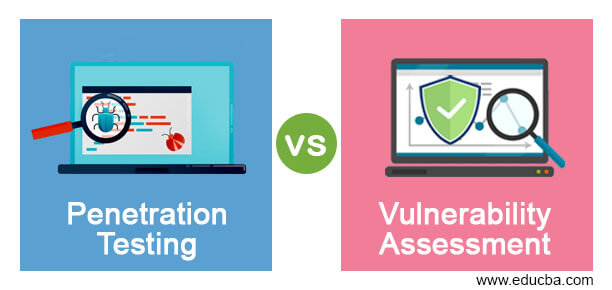Updated April 19, 2023

Difference Between Penetration Testing vs Vulnerability Assessment
The following article provides an outline for Penetration Testing vs Vulnerability Assessment. Many people use penetration testing and vulnerability assessment interchangeably because of marketing hype or misunderstanding. In terms of their aims and other factors, however, the terms are both distinct from each other. However, penetration testing and vulnerability assessment are distinct from each other with respect to their aims and other factors. Before differentiating these two terms it is important to understand what both the terms mean.
Penetration testing imitates the activities of an external or/and internal cyber intruder which is built to breach the confidentiality of the information and hack sensitive data or interrupt the organization’s normal functioning. Thus, a penetration tester who is also called an ethical hacker attempts to manipulate critical networks and gain access to sensitive data with the aid of specialized tools and techniques.
Vulnerability assessment is the method used in a given setting to discover and calculate security vulnerabilities that are scanning for vulnerabilities. It is a thorough assessment of the status of network security and result analysis. Also, it recognizes possible attacks or vulnerabilities and provides effective steps to mitigate or reduce those weaknesses below the level of risk.
Head to Head Comparison Between Penetration Testing vs Vulnerability Assessment (Infographics)
Below are the top 9 differences between Penetration Testing vs Vulnerability Assessment:
Key Difference Between Penetration Testing vs Vulnerability Assessment
Let us discuss some of the major key differences between Penetration Testing vs Vulnerability Assessment:
- Vulnerability assessment is a method of finding and measuring the vulnerability of the system. Whereas penetration testing finds vulnerabilities and exploits them to take advantage of the system.
- Vulnerability assessment is Automated System and only takes minutes whereas pen tester has to do penetration testing manually and it takes a number of days.
- In vulnerability assessment, end result is a list of vulnerabilities that is often prioritized by their potency. On the other hand, penetration testing is more goal-oriented. It helps in charting the path which will be taken by the attacker to take over the system
- In vulnerability assessment, it is recommended when the system already has known security issues or the organization has no security measures and wants to get started in that area. On the contrary, penetration testing is recommended when the company has a good level of security and want to search for some hidden vulnerabilities.
- Vulnerability assessment emphasizes breadth over depth which means it is more concerned about finding more vulnerabilities instead of understanding the true severity of each. On the other hand, penetration testing
- Emphasize depth over breadth. Pen testers discover vulnerabilities with specific goals in mind. They want to know how a potential hacker can exploit the situation to take over the system.
- Vulnerability assessment should be done at least quarterly, mainly after the loading of new equipment or major changes to the network while Pen testing should be done annually after significant changes.
- Vulnerability assessment is performed on non-critical systems whereas penetration testing is performed on critical real-time systems.
- Vulnerability assessment provides a detailed framework for what vulnerabilities exist and what has changed since the last analysis and it is a thorough analysis of the target system. On the other hand, penetration testing effectively identifies the information that has been compromised. It is non-intrusive, environmental review, documentation, and analysis.
Penetration Testing vs Vulnerability Assessment Comparison Table
Let’s discuss the top comparison between Penetration Testing vs Vulnerability Assessment:
| Sr. No | Penetration Testing |
Vulnerability Assessment |
| 1 | It finds vulnerabilities and exploits them to take advantage of the system. | This is a method of finding and measuring the vulnerability of the system. |
| 2 | A penetration test is more goal-oriented. It helps in charting the path which will be taken by the attacker to take over the system. | The end result is a list of vulnerabilities that are often prioritized by their potency. |
| 3 | Pen tester has to do it manually. | It is an automated system. |
| 4 | It takes a number of days | It just takes minutes. |
| 5 | Emphasize depth over breadth. Pen testers discover vulnerabilities with specific goals in mind. They want to know how a potential hacker can exploit the situation to take over the system. | Emphasizes breadth over depth which means it is more concerned about finding more vulnerabilities instead of understanding the true severity of each. |
| 6 | It is performed on critical real-time systems. | It is performed on non-critical systems. |
| 7 | Pen testing should be done annually after significant changes. | Vulnerability assessment should be done at least quarterly, mainly after the loading of new equipment or major changes to the network. |
| 8 | It effectively identify the information that has been compromised. | It provide a detailed framework for what vulnerabilities exist and what has changed since the last analysis. |
| 9 | It is non-intrusive, environmental review, documentation and analysis. | It is thorough analysis of the target system. |
Conclusion
We saw from this article that both pen test and vulnerability scan are two separate tasks that are performed to make the system secure from attacks. If required, we can use both together. The vulnerability assessment identifies the potential vulnerabilities, and the penetration test exploits these vulnerabilities to expose the extent of harm that can occur to business-critical data. They are carried out to repair the vulnerabilities and prevent the information system from any future threats and security breaches.
Recommended Articles
This is a guide to Penetration Testing vs Vulnerability Assessment. Here we discuss key differences with infographics and comparison table. You may also have a look at the following articles to learn more –

